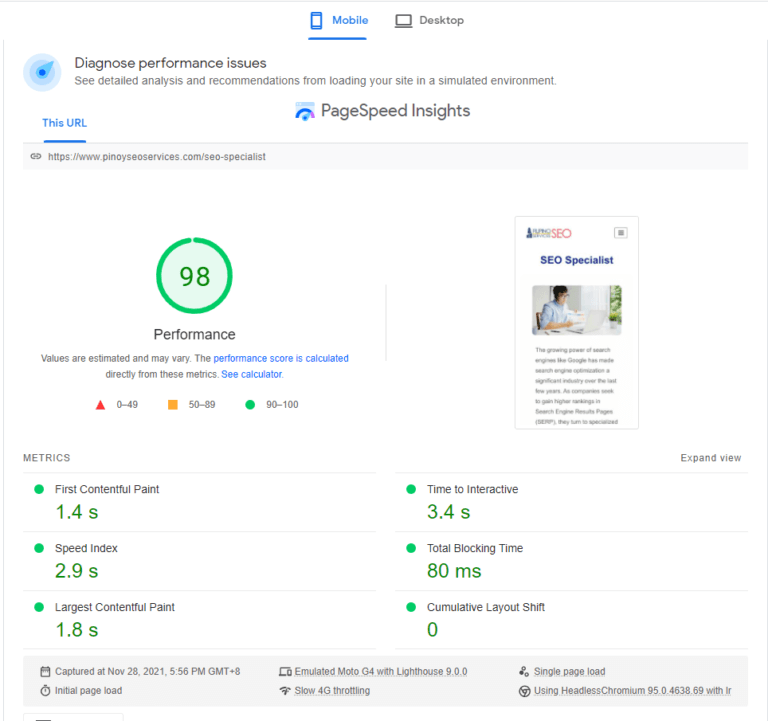Mobile SEO: How to Improve your Mobile Site?
Now that you know why mobile is so important, what can you do to ensure that your website meets the right standards?
Your site needs to be mobile-friendly. Therefore, mobile optimization should be your number one priority. Optimizing a mobile site means improving its performance and ensuring it offers users an excellent user experience, but how do you do it?
What is mobile SEO?
Mobile search engine optimization is a process that ensures that visitors who visit your site from mobile devices have an optimized experience with no viewing issues.
By optimizing your mobile site for mobile devices, you make sure your content is presented to a mobile user in the best possible way. For some time, Google has used the mobile version of the site to determine its ranking. It will be difficult for your mobile site to get good rankings if it’s not up to par or lacks good content. When you miss out on some decent rankings in the search engines, you’ll also miss out on the opportunity to make some income.
What is Google’s Mobile-First Index?
Google’s Mobile-First Index ranks search results based solely on mobile versions. But, of course, this also happens if you search from a desktop computer.
Before this update, Google’s index mixed desktop and mobile results.
When someone searches from an iPhone, Google will display mobile results. If someone searched on a desktop, they would see “desktop results.” Now, regardless of your device, Google shows you result from their mobile index.
When your site is already well optimized for search engines, you only need to think about a few other things when optimizing Google’s move to Mobile-First Indexing and mobile devices.
Improve the page speed
Among the most important things you can do to improve mobile SEO for your site is to increase the site’s loading speed. People who visit slow-loading sites often leave them and never come back. Speed has been a ranking factor for years, and Google is increasingly focusing on fixing it.
Optimize the images
One quick and easy way to speed up your site is to optimize the images. For example, scale the images to the correct size and make them smaller like WordPress plugins. You might also consider serving those images in next-generation formats, such as WebP.
Minify the code
Beyond optimizing the page speed and images, you’ll also want to minify the code. The smaller, the better. Why? Because incorrect sizing and any request your site has to make may lead to a longer page load. Minifying code can help minimize requests. You group assets like CSS and JavaScript, so the browser has to load fewer files, resulting in faster site loading. Plugins like WP Rocket can do all the caching needs.
Reduce redirects
Redirecting leads a visitor from one page to another due to deletion or relocation. If done right, this can lead to a good user experience. However, the more redirects you use, the slower your site will be. Avoid making endless redirects. Also, avoid having links that point to deleted posts redirected to new ones.
Don’t block JavaScript, CSS, or images
Blocking these assets will make it hard for Google to access your site, leading to bad rankings. Google uses these elements to determine whether a site is responsive or not.
Optimize title and meta description
When a user uses a mobile device to search, keep in mind they use less screen space. So, be as concise as possible when creating titles, URLs, and meta descriptions in search engine result page or SERPs.
Optimize for local search
Consider optimizing your mobile content for local search if your business has a local element. The site’s metadata must include your name, address, and phone number, as well as your city and state.
Use structured data
Every site needs structured data. Structured data allows you to describe your content in a way that search engines comprehend. By doing so, you have a direct line of communication with the search engine. As a result, search engines might reward you with some fantastic results in return. Structured data should be the same for mobile and desktop – otherwise, Google might get confused. The Yoast SEO plugin automatically adds structured data for the most critical parts of your site, and you can customize it to that of your liking.
Enhance the size of the tap targets
There is nothing worse than accidentally clicking a button, link, or menu item because of touch-button issues on the navigation screen. Unfortunately, mobile users also get frustrated when screen navigation is not easy.
Don’t use pop-ups
Google penalizes websites that use large pop-ups or interstitials for promoting sign-up forms, ads, or newsletters. These can delay a user’s ability to find the content they are searching for.
A mobile website has become the new standard. However, there’s more to mobile SEO than great content and perfect presentation; it’s about creating a flawless user experience. So make sure that your mobile site is ideal not only for Google but also for your visitors.




